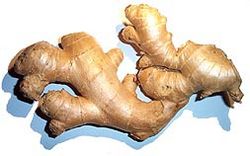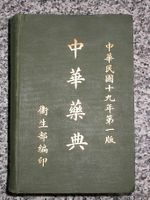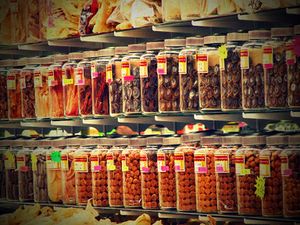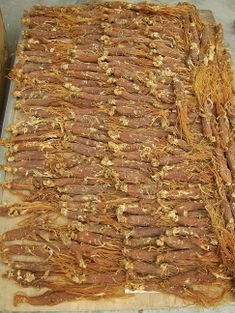الأعشاب الصينية
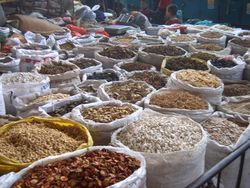
Dried herbs and plant portions for Chinese herbology at a Xi'an market
الأعشاب الصينية
الاستخدام الطبي
تاريخ
تصنيف الاعشاب الصيني
Chinese physicians used several different methods to classify traditional Chinese herbs:
- The Four Natures (pinyin: sìqì; simplified Chinese: 四气; traditional Chinese: 四氣; or 四性)
- The Five Tastes (五味; pinyin: wǔwèi)
- The meridians (pinyin: jīngluò; simplified Chinese: 经络; traditional Chinese: 經絡; )
The earlier (Han through Tang eras) Ben Cao (Materia Medicae) began with a three-level categorization:
- Low level -- drastic acting, toxic substances;
- Middle level -- medicinal physiological effects;
- High level -- health and spirit enhancement
أعشاب صينية أخرى
- Citrus reticulata (橘皮)
- Curcumae (郁金)
- Dalbergia odorifera (降香)
- Hirudo medicinalis (水蛭)
- Myrrh (没药)
- Olibanum (乳香)
- Persicaria (桃仁)
- Polygonium (虎杖)
- Sparganium (三棱)
- Zedoary (莪朮)
- Clematis (威灵仙)
المصادر
مصادر عامة
- Wong, Ming (1976). La Médecine chinoise par les plantes. Le Corps a Vivre series. Éditions Tchou.
أنظر أيضاً
- Chinese classic herbal formula
- Compendium of Materia Medica
- Herbalism, for the use of medicinal herbs in other traditions.
- Li Shizhen
- Pharmacognosy
- Star anise
- Japanese star anise
- Traditional Chinese medicine
- TCM Materia Medica (Plant)
- Traditional Japanese medicine
- Traditional Korean medicine
- Yaoxing Lun
وصلات خارجية
- Herbs - A comprehensive listing of Chinese herbs grouped by their action
- Chinese herb dictionary
- Classic Formulae of Traditional Chinese Medicine
- More information on Traditional Chinese Medicine
- Chinese Herbal Formulas
- Holistic Chinese Herbs
الموارد التعليمية
- Acupuncture & Integrative Medicine College, Berkeley | Acupuncture School - Chinese Herbal Medicine (Berkeley, CA, USA)
- Tai Sophia Institute - Chinese Herb Certificate Program (Laurel, MD, USA)
- Institute of Chinese Herbology (Concord, CA, USA)
ملف:ChinesePatent-PlumFlower.png
Characteristic little black pills of Chinese patent medicine
50من الأعساب الأساسية
In Chinese herbology, there are 50 "fundamental" herbs, as given in the reference text [1], although these herbs are not universally recognized as such in other texts. The herbs are:
- Agastache rugosa[2] - huò xiāng (藿香)[3]
- Alangium chinense[4] - bā jiǎo fēng (八角枫)[5]
- Anemone chinensis (syn. Pulsatilla chinensis)[6] - bái tóu weng (白头翁)[5][7]
- Anisodus tanguticus - shān làng dàng (山莨菪)[8]
- Ardisia japonica - zǐ jīn niú (紫金牛)[9]
- Aster tataricus - zǐ wǎn (紫菀)
- Astragalus propinquus (syn. Astragalus membranaceus)[10] - huáng qí (黄芪)[11] or běi qí (北芪)[11]
- Camellia sinensis - chá shù (茶树) or chá yè (茶叶)
- Cannabis sativa - dà má (大麻)
- Carthamus tinctorius - hóng huā (红花)
- Cinnamomum cassia - ròu gùi (肉桂)
- Cissampelos pareira - xí shēng téng (锡生藤) or (亞乎奴)
- Coptis chinensis - duǎn è huáng lián (短萼黄连)
- Corydalis ambigua - yán hú suǒ (延胡索)
- Croton tiglium - bā dòu (巴豆)
- Daphne genkwa - yuán huā (芫花)
- Datura metel - yáng jīn huā (洋金花)
- Datura stramonium (syn. Datura tatula)[12] - zǐ huā màn tuó luó (紫花曼陀萝)
- Dendrobium nobile - shí hú (石斛) or shí hú lán (石斛兰)
- Dichroa febrifuga[13] - cháng shān (常山)
- Ephedra sinica - cǎo má huáng (草麻黄)
- Eucommia ulmoides - dù zhòng (杜仲)
- Euphorbia pekinensis[14] - dà jǐ (大戟)
- Flueggea suffruticosa (formerly Securinega suffruticosa) - yī yè qiū (一叶秋)[15]
- Forsythia suspensa - liánqiào (连翘)
- Gentiana loureiroi - dì dīng (地丁)
- Gleditsia sinensis - zào jiá (皂荚)
- Glycyrrhiza uralensis - gān cǎo (甘草)[16]
- Hydnocarpus anthelminticus (syn. H. anthelminthica) - dà fēng zǐ (大风子)
- Ilex purpurea - dōngqīng (冬青)
- Leonurus japonicus - yì mǔ cǎo (益母草)
- Ligusticum wallichii[17] - chuān xiōng (川芎)
- Lobelia chinensis - bàn biān lián (半边莲)
- Phellodendron amurense - huáng bǎi (黄柏)
- Platycladus orientalis (formerly Thuja orientalis) - cèbǎi (侧柏)
- Pseudolarix amabilis - jīn qián sōng (金钱松)
- Psilopeganum sinense - shān má huáng (山麻黄)
- Pueraria lobata - gé gēn (葛根)
- Rauwolfia serpentina - shégēnmù (蛇根木), cóng shégēnmù (從蛇根木), or yìndù shé mù (印度蛇木)
- Rehmannia glutinosa - dìhuáng (地黄) or gān dìhuáng (干地黄)[18]
- Rheum officinale - yào yòng dà huáng (药用大黄)
- Rhododendron tsinghaiense - Qīng hǎi dù juān (青海杜鹃)
- Saussurea costus - yún mù xiāng (云木香)
- Schisandra chinensis - wǔ wèi zi (五味子)
- Scutellaria baicalensis - huáng qín (黄芩)
- Stemona tuberosa - bǎi bù (百部)
- Stephania tetrandra - fáng jǐ (防己)
- Styphnolobium japonicum (formerly Sophora japonica) - huái (槐), huái shù (槐树), or huái huā (槐花)
- Trichosanthes kirilowii - guā lóu (栝楼)
- Wikstroemia indica - liǎo gē wáng (了哥王)
- ^ Wong, Ming (1976). La Médecine chinoise par les plantes. Le Corps a Vivre series. Éditions Tchou.
- ^ "Agastache rugosa - Plants For A Future database report". Retrieved 2008-02-14.
- ^ "Agastache rugosa in Flora of China @ efloras.org". Retrieved 2008-02-19.
- ^ "Alangium chinense - Plants For A Future database report". Plants for a Future. 2004. Retrieved 2008-02-05.
{{cite web}}: Unknown parameter|month=ignored (help) - ^ أ ب "Alangium chinense in Flora of China @ efloras.org". Retrieved 2008-02-14.
- ^ "Anemone chinensis information from NPGS/GRIN". USDA, ARS, National Genetic Resources Program. Retrieved 2008-02-05.
- ^ "Anemone chinensis information from NPGS/GRIN". USDA, ARS, National Genetic Resources Program. Retrieved 2008-02-05.
- ^ "Anisodus tanguticus in Flora of China @efloras.org". Retrieved 2008-02-05.
- ^ Flora of China: Ardisia japonica
- ^ "Astragalus propinquus". ILDIS LegumeWeb. International Legume Database & Information Service. 2005-11-01. Retrieved 2008-01-03.
- ^ أ ب "Huang qi, Complementary and Alternative Healing University". Retrieved 2008-02-19.
- ^ "Datura stramonium information from NPGS/GRIN". Retrieved 2008-02-05.
- ^ "Dichroa febrifuga - Plants For A Future database report". Retrieved 2008-02-05.
- ^ "Euphorbia pekinensis - Plants For A Future database report". Retrieved 2008-02-05.
- ^ "Securinega suffruticosa - Plants For A Future database report". Retrieved 2008-02-06.
- ^ "Glycyrrhiza uralensis - Plants For A Future database report". Retrieved 2008-02-08.
- ^ "Ligusticum wallichii - Plants For A Future database report". Retrieved 2008-02-21.
- ^ Rehmannia glutinosa
This article contains content from Wikimedia licensed under CC BY-SA 4.0. Please comply with the license terms.
